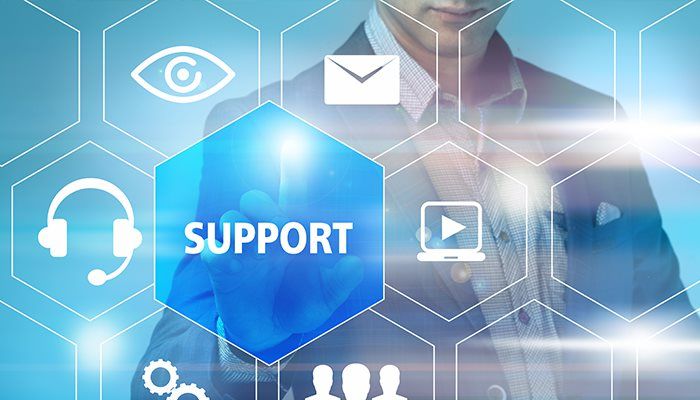Every business relies on ITSM tools to execute processes that drive operational efficiency and satisfy end-user requirements. But a quick Google search shows no shortage of ITSM tools—the ITSM solutions market is constantly evolving, with a diverse range of products available to serve a variety of functional requirements and maturity models. In fact, the cloud-based ITSM solutions market is projected to grow by 14.9% year-over-year.
So how do you know what makes ITSM software great? Let’s look at three steps in choosing the best ITSM solution for your company, and explore the top ITSM features in ITSM software.
How to select the best ITSM solution
According to The State of IT Service Management 2017, ITSM plays a crucial role in driving successful digital transformation. ITSM technology features allow organizations to adopt the most effective service management principles from multiple frameworks such as DevOps, Lean, Agile, and ITIL. The right set of ITSM features and capabilities are necessary for organizations to enhance end-user experience and boost employee productivity.
This choice, however, should be backed with a strategic evaluation of the current state of IT service management and future expectations before opting for the latest new ITSM technologies available in the market today. You should never define your ITSM strategies based on included or limited features in your software.
- Identify the gaps in your ITSM processes. Start by evaluating your company’s service management maturity. Where is it now, and what does your ideal ITSM look like? How is your current ITSM preventing desired business outcomes?
- Evaluate the solutions available in the market. Understand the true technology requirements for an optimal ITSM strategy.
- Future-proof your technology needs. As much as possible, future proof your investments in technology—your business and IT requirements for ITSM tools will evolve as the business scales. For example, cutting-edge ITSM frameworks are drawing on automation and self-service capabilities.
Top ITSM features
The best ITSM features for any use case are subjective and vary between organizations, of course, but here are some essential must-haves for any great ITSM software.
Asset discovery and management
Know your IT hardware and software assets. Strong visibility and control into the IT environment depends on the ability of IT to effectively manage changes, configurations, provisioning and deployment, licensing, and incidents. The ITSM technology should enable data-driven decisions across all IT assets and the network without overwhelming IT professionals. Remote support and automated configuration management depends on how well the solution tracks incidents and devices in real-time.
Configuration management
The state of hardware and software assets changes rapidly in complex IT infrastructure environments. Configurations must meet the requirements of different users and follow organizational policies. Accurate and up-to-date information of all configuration items must be maintained in the configuration management database (CMDB) to manage real-time changes. The best ITSM technologies enrich the ecosystem workflow with CMDB capabilities that track IT assets and their dependencies across multi-cloud environments. Automating these processes reduces risks associated with IT changes such as downtime and cost overruns.
Incident and problem management
IT downtime costs business organizations $5,600 to $9,000 per minute, according to Gartner. ITSM tools offer proactive, unified, and automated incident and problem management to help address IT issues before the impact escalates and reaches end-users. Advanced ITSM technologies may include machine learning capabilities to reduce the noise in log metrics and event data, correlate patterns of anomalous behavior, and identify the problem root cause for permanent issue resolution. An effective ITSM solution will allow IT to accurately predict future issues, allowing you to take the necessary preventive measures before end-users are affected.
Self-service provisioning and support desk
DevOps and Agile organizations empower their workforce with self-service IT service provisioning capabilities. This means dev teams are more self-sufficient, reducing the burden on IT Operations. Advanced ITSM technologies offer intuitive self-service and support desk portal designed to serve end-users efficiently. An effective self-service portal not only directs end-users to solutions, but also empowers them with control and capabilities to solve the issues without the involvement of IT departments. For example, it’s no longer sufficient to request a new hardware or software asset via self-service portals. Users also demand access to their personalized configurations, profile and information. The future of self-service ITSM ensures that these capabilities are delivered to end-users without compromising security and policy compliance.
Knowledge management
Documenting and providing access to vast knowledge is the first step to realizing self-service support and issue resolution capabilities. ITSM technologies that offer workflows to publish, manage, and utilize growing knowledge assets help reduce the service burden on IT and boost end-user satisfaction. Integration with self-service portal, contextual and customized search, document versioning, and translations and analytics dashboards are some of the popular ITSM knowledge management capabilities offered in the market today. The result is an effortless self-service experience for the IT community, simplifying the knowledge creation and management process.
Metrics, analytics, BI & reporting
The best ITSM solutions empower users with intuitive and actionable knowledge. Instead of providing overwhelming metrics and KPI reporting data, users require actionable insights based on contextual knowledge. ITSM technologies must allow users to create useful dashboards using out-of-the-box templates and advanced customization options. The analytics and reporting solution should help answer key business questions, guiding ongoing improvements in IT service delivery. Machine learning algorithms that assist in record creation for incidents and performance reports based on short description boost end-user productivity.
Multi-cloud support
IT users require seamless service experience for apps running across multi-cloud infrastructure. IT faces constant challenge to manage incidents, configurations and release cycles across a complex network of multi-cloud infrastructure environment. ITSM technologies should balance these requirements by managing application interdependence across multiple platforms and infrastructure models. IT should be able to extend visibility and control into usage, ownership and cost of multi-cloud apps and services. Centralized dashboards providing accurate knowledge may be critical to optimize resource utilization in multi-cloud environments.
Automated workflows and DevOps integration
Automation is a leading strategic priority for ITSM technologies. Workflows in managing configuration changes, incidents and problems, knowledge and other ITSM applications should be reliable and repeatable. Integrating IT service operations and DevOps automation technologies can empower DevOps teams with self-service ITSM capabilities. While progressive organizations are readily adopting DevOps frameworks, the working groups in Dev, Ops, and QA departments tend to use different solutions to track and manage their IT services. ITSM technologies that consolidate and unify these capabilities help reduce silos between the collaborating cross-functional DevOps teams.
Remember that ITSM software doesn’t have to be the top-rated option to be the best solution for your company. Organizations focused on service desk may only require basic ITSM features to adopt self-service capabilities, while companies with DevOps environments may require advanced machine learning-based reporting capabilities to identify SDLC process bottlenecks and reduce waste processes.
These postings are my own and do not necessarily represent BMC's position, strategies, or opinion.
See an error or have a suggestion? Please let us know by emailing blogs@bmc.com.






